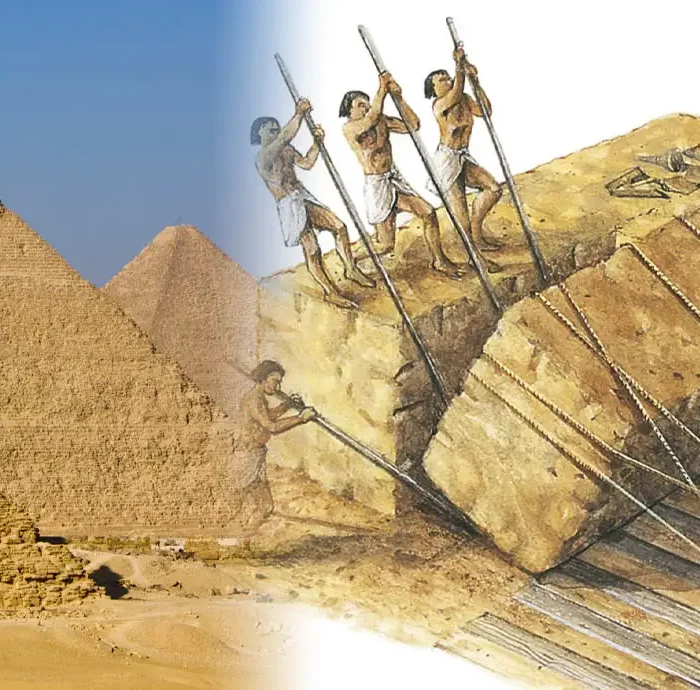
How were the pyramids Built
The Pyramids of Giza, one of the seven wonders of the ancient world, have stood for over 4,500 years as a testament to the ingenuity and skill of the ancient Egyptians. These massive structures, built during the Old Kingdom period of ancient Egypt, continue to amaze visitors and researchers alike with their sheer size and complexity. But how were these monumental structures constructed? How did the builders manage to move such enormous blocks of stone into place without modern technology?
In this article, we will explore some of the theories behind how these incredible feats of engineering were accomplished.
Fascination with Ancient Egyptian Pyramids
How were the pyramids built, The construction of the ancient Egyptian pyramids remains one of the most fascinating engineering feats in history. These complex structures were built during a time when technology was still at its infancy, and yet they have managed to stand the test of time for thousands of years. The process involved quarrying massive blocks of limestone and granite from nearby quarries, transporting them across great distances, and assembling them with precision to create these monumental tombs.
One theory suggests that ramps were used to transport the heavy stones up the pyramid’s inclined surface as it was being constructed. However, this method would have required an enormous amount of manpower and resources. Another hypothesis proposes that internal ramps were constructed within each pyramid’s core to move blocks upwards as work progressed on each level.
Despite numerous theories and speculations about how these ancient wonders were built, many mysteries surrounding their construction still remain unsolved. It is a testament to the creativity and ingenuity of our ancestors that these monuments continue to fascinate people from all over the world even today.
History of Pyramid Buildings in Egypt
The construction of pyramids in Egypt dates back to the Old Kingdom period, around 2686-2181 BC. The first pyramid was built by King Djoser, who commissioned his architect Imhotep to design a grand tomb that would ensure his eternal life after death. Imhotep came up with the idea of constructing a stepped pyramid, which consisted of six tiers made out of limestone blocks.
Over time, the design and construction techniques evolved into what is commonly known as the true pyramid shape. The most famous examples include the Great Pyramid of Giza, built for King Khufu during the Fourth Dynasty reign (2580-2560 BC), and his son’s pyramid complex at Dahshur.
Constructing these massive structures required an enormous amount of manpower and resources. Workers quarried stones from nearby cliffs and transported them using sleds pulled by oxen or human labor. They then used ramps to move the stones into place and used simple machines like levers to lift them into position. It is estimated that it took around 20 years for up to 100,000 workers to build Khufu’s Great Pyramid alone. Despite its immense size and complexity, ancient Egyptian builders were able to achieve some remarkable feats in engineering that still baffles modern-day scientists today.
Planning and Designing the Pyramids
The planning and designing of the pyramids were crucial to their construction. The architects and engineers carefully calculated the angles, measurements, and materials needed for each pyramid. They also had to consider the location of the pyramid in relation to the Nile River and other important landmarks.
One of the most impressive feats of engineering was the precise alignment of each side of the pyramid with true north, which required accurate astronomical observations. The shape and size of each block used in construction were also carefully planned to ensure stability and durability over time.
Despite being built over 4,500 years ago, many aspects of how these massive structures were designed and constructed remain a mystery. However, recent archaeological discoveries have shed new light on some aspects of planning and design techniques used by ancient Egyptians to build these incredible monuments that still stand today as testaments to human ingenuity.
Construction Techniques Used
The construction of the pyramids is considered a remarkable achievement in engineering and architecture. The techniques used by ancient Egyptians to build these massive structures have fascinated historians and scholars for centuries. One of the most significant methods was quarrying stones from nearby mountains, which were then transported to the site using wooden sleds pulled by oxen or people.
Another technique that can be seen in the construction process was using ramps to transport heavy blocks up to great heights. These ramps were made of mud bricks and were inclined at an angle of about 20 degrees. Once the block reached its intended height, it was moved laterally into position, often with ropes and pulleys.
The final step involved finessing each stone into a precise location so that they fit together perfectly without any gaps. This technique is known as precision engineering, which involves cutting each block with absolute accuracy. It’s said that some limestone casing stones were cut so precisely that even today, it isn’t possible to slip a piece of paper between them.
In conclusion, although modern construction techniques have advanced significantly since ancient times, the pyramids remain one of the most awe-inspiring feats ever achieved by humankind. It takes nothing away from what we do today; instead, it speaks volumes about our ancestors’ ingenuity and perseverance who constructed these incredible structures with limited resources available at their disposal.
Moving and Lifting Heavy Stone Blocks
One of the most impressive feats of engineering in ancient times is the construction of the pyramids. These massive structures were built using large stone blocks that weighed hundreds of tons. The process of moving and lifting such heavy blocks was a complex task that required careful planning and precise execution.
To move the stone blocks, workers used sledges and rollers made from wood or copper. They would place the block on a sledge and pull it across the ground using ropes attached to horses or oxen. To lift the blocks into place, workers used ramps made from mud bricks or limestone slabs. They would build a ramp up to the level where they wanted to place the block, then use levers and pulleys to lift it into position.
Despite these ingenious methods, moving and lifting these heavy stone blocks was an incredibly difficult task that required a tremendous amount of manpower. It is estimated that thousands of workers were involved in building each pyramid, working tirelessly for years to complete these monumental structures that still stand today as a testament to their ingenuity and skill.
The Role of Labor and Workforce
The construction of the pyramids is a testament to the significant role played by labor and workforce in ancient Egypt. The pyramid-building process was an enormous undertaking, requiring a great deal of manual labor and skilled craftsmen. The pyramids were built using limestone blocks weighing up to 80 tons, which had to be quarried and transported from miles away.
To achieve such a monumental task, the pharaohs relied on organized labor systems that were not dissimilar from modern-day unions. Thousands of workers were employed through community-based programs known as “corvée” labor. These workers came from different parts of Egypt and worked together under strict supervision.
The workforce involved in building the pyramids varied depending on the phase of construction, but it is estimated that at least 100,000 workers were needed over several decades. Although slaves are often associated with pyramid-building in popular culture, most of the workers who built the pyramids were paid laborers who received food, shelter, and basic medical care in exchange for their work.
Conclusion: Mysteries and Wonders of Pyramid Building
In conclusion, the mysteries and wonders surrounding pyramid building continue to fascinate scientists and historians alike. Although many theories have been proposed over the years, there is still no consensus on exactly how the pyramids were built. Some believe that slaves were used to transport the massive stones, while others suggest that sophisticated systems of pulleys and ramps were employed.
Despite these uncertainties, what is clear is that building a pyramid required immense manpower and resources. The process of quarrying, transporting, and assembling millions of limestone blocks was an enormous undertaking that would have taken decades to complete. And yet, despite the challenges involved in constructing such a monumental structure, the ancient Egyptians managed to build some of the most impressive architectural feats in human history.
Read Also…. memento-mori














